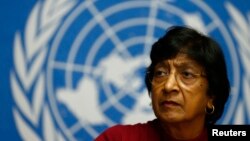UNITED NATIONS —
A new U.N. report shows limited progress in fighting sexual violence in the Democratic Republic of Congo, where too few attackers have been brought to justice. The cases of sexual violence are highest in the eastern part of the country, where armed groups continue to threaten civilians.
The statistics are alarming: during the four-year period ending in December 2013, there were more than 3,600 victims of sexual violence. Most were women, but there were also nearly 1,000 children and 81 men.
U.N. High Commissioner for Human Rights Navi Pillay told a press conference Wednesday that the victims ranged in age from 2 to 80.
“Based on the information gathered, it appears that armed groups and state agents were each allegedly responsible for about half of all the cases of sexual violence that we recorded," said Pillay.
The report found that sexual violence was often committed during armed attacks aimed at gaining control over territories rich in natural resources. Villages were a primary target and victims were violated in their homes, the fields where they worked, while going to the market or collecting water.
The U.N. Joint Human Rights Office, which conducted the study, said the incidence of sexual violence is higher in the conflict provinces of North and South Kivu and Orientale. Nearly half of all victims were from North Kivu.
The study found many obstacles to justice for victims, including a weak national judicial system which lacks the means to conduct investigations, interview and protect victims and witnesses, as well as the low rate of arrests and convictions. Navi Pillay said improved political will at the highest levels has not sufficiently reduced sexual attacks, and she urged Kinshasa to step up its efforts.
“I call on the government to prioritize the fight against impunity for crimes of sexual violence, to promptly complete effective and independent investigations, and to prosecute alleged perpetrators, including those suspected of having command responsibility," she said.
Since 2011, military courts have convicted 187 individuals of sexual crimes, but most were low-ranking soldiers, and very few were senior officers or members of armed groups.
The statistics are alarming: during the four-year period ending in December 2013, there were more than 3,600 victims of sexual violence. Most were women, but there were also nearly 1,000 children and 81 men.
U.N. High Commissioner for Human Rights Navi Pillay told a press conference Wednesday that the victims ranged in age from 2 to 80.
“Based on the information gathered, it appears that armed groups and state agents were each allegedly responsible for about half of all the cases of sexual violence that we recorded," said Pillay.
The report found that sexual violence was often committed during armed attacks aimed at gaining control over territories rich in natural resources. Villages were a primary target and victims were violated in their homes, the fields where they worked, while going to the market or collecting water.
The U.N. Joint Human Rights Office, which conducted the study, said the incidence of sexual violence is higher in the conflict provinces of North and South Kivu and Orientale. Nearly half of all victims were from North Kivu.
The study found many obstacles to justice for victims, including a weak national judicial system which lacks the means to conduct investigations, interview and protect victims and witnesses, as well as the low rate of arrests and convictions. Navi Pillay said improved political will at the highest levels has not sufficiently reduced sexual attacks, and she urged Kinshasa to step up its efforts.
“I call on the government to prioritize the fight against impunity for crimes of sexual violence, to promptly complete effective and independent investigations, and to prosecute alleged perpetrators, including those suspected of having command responsibility," she said.
Since 2011, military courts have convicted 187 individuals of sexual crimes, but most were low-ranking soldiers, and very few were senior officers or members of armed groups.





